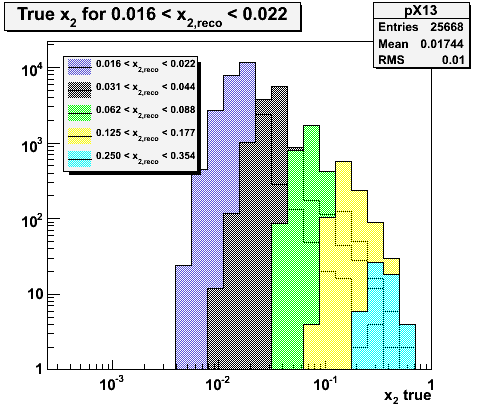- jwebb's home page
- Posts
- 2019
- 2018
- 2017
- 2016
- 2015
- 2014
- 2013
- November (1)
- October (1)
- September (1)
- July (1)
- June (1)
- April (1)
- March (3)
- February (1)
- January (1)
- 2012
- 2011
- December (2)
- September (3)
- August (5)
- July (6)
- June (6)
- May (1)
- April (5)
- March (5)
- February (2)
- January (2)
- 2010
- December (3)
- October (3)
- September (2)
- August (2)
- June (2)
- May (4)
- April (4)
- March (2)
- February (4)
- January (10)
- 2009
- 2008
- 2007
- 2006
- July (1)
- My blog
- Post new blog entry
- All blogs
Pythia study to estimate calibration requirements for the gamma+jet A_LL measurement
Abstract: At leading order, gamma+jet coincidences provide access to the initial state partonic momentum fractions. Reconstruction of the initial state kinematics can be performed by measuring the pT of the gamma, and the pseudorapidities of the gamma and jet. Detector resolution and gain calibrations can degrade the precision with which these quantities can be measured. In this study we try to determine what quantities limit our ability to reconstruct x1 and x2.
1.0 Configuration
Pythia configuration
// Generator
//pythia.readString("HardQCD:all = on");
pythia.readString("PromptPhoton:all = on");
pythia.readString("PhaseSpace:pTHatMin = 4.");
pythia.readString("Random:seed = 0");
pythia.init( 2212, 2212, roots );CellJet (aka PyCell) configuration
CellJet SuperSTAR( 2.0, 4*20, 120, 2 ); // barrel granularity over full -2 to 2 coverage2.0 Analysis
Generate 1M events on my laptop. Perform the following operations on every event:
- Loop over all particles in the event record.
- Find the leading gamma in the event (isFinal() == true)
- Find the leading jet in the event
-
Reconstruct the kinematics
x1 = pTγ ( exp ( +ηγ ) + exp (+ηjet ) )
x2 = pTγ ( exp ( -ηγ ) + exp (-ηjet ) )
- Fill histograms comparing true to reconstructed initial state kinematics
3.0 Kinematic Reconstruction Assuming a Perfect Detector
- Assume a perfect detector (no energy resolution or gain smearing effects)
- Fiducial cuts to mimic STAR midrapidity acceptance
- min pT = 6 GeV
- -0.9 < η gamma < 1.9
- -0.9 < η jet < 1.2
- find leading gamma, leading jet at least 90 degrees away
- Reconstruct leading order kinematics
- Compare x2 reconstructed to x2 thrown
Figure 1 -- Distribution of generated x2 (from pythia record) versus reconstructed x2.


Figure 2 -- Reconstructed vs. true x2.

Observations:
The resolution with which we can reconstruct the initial state kinematics is not as good as I would have expected. Take for example the evets which reconstruct in the 0.016 < x2 < 0.022 bin. Over 1/2 of these events have migrated from neighboring bins. About 8% from x2 <~ 0.01. The events in this bin have a mean x2 (true) of 0.017 with a sigma of 0.01. Expressed as a percentage: sigma(x2) / (x2) ~ 58%. Even a 10% gain variation isn't going to affect this.
Where does this reconstruction resolution come from? Possibly from here...
Figure 3 -- Delta phi vs Delta eta for the photon (left) and jet (right). The difference is between the stable final state photon or reconstructed jet, and the photon or gluon.


Compare the jet eta and phi resolutions to the plots in the proposal... the proposal quotes a FWHM of about 0.16 for the eta resolution... which is significantly smaller than the sigma=0.35 which I am getting. Something must be screwy someplace.
Groups:
- jwebb's blog
- Login or register to post comments
